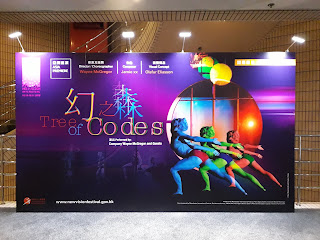Being Chinese and Female in Paris (Exhibition review on "Song of Spring: Pan Yu-lin in Paris")
31 Oct 2018 | Ashley
From mid September to 6 Jan 2019, Asia Society is presenting an art exhibition called "Song of Spring: Pan Yu-lin in Paris" (《春之歌:潘玉良在巴黎》). If you are familiar with Greco-Roman paintings, you might recall seeing nymphs bathing under blossoming trees. This is what you will see in this exhibition, but with a twist of Asian implications, proudly presented by the Chinese female artist, Pan Yu-lin, through female models' facial features, hairstyles, dance poses, and her use of Chinese ink technique.
What interests me the most about her works is her tendency to intertwine Western and Asian characteristics. Being one of the earliest Chinese female artists staying in France to learn art, I imagine that she felt the need to establish her own definition of herself in a foreign country. From her works presented in the first chamber, we see portraits of people from different ethnic backgrounds, those who were generally considered less privileged in society. This choice of subject seems to reveal her need to gather ethnic minorities in a white-dominated society to provide herself with emotional support as a Chinese woman in France.
However, as we move inwards to the other chambers, we see more and more of her fascination with nature and the idealised space for female liberty, especially that of Chinese women. In the final chamber, the painting Pleasure on the Beach (1959) (《海濱樂》), I think the artist made her ultimate attempt to achieve the "Song of Spring" idea, which intended to visually liberate Chinese women in secluded nature. You will notice that the women in the painting are not representations of Oriental or Western ideals of female beauty. Their body figures are lumpy, big, yet they shine with such confidence and comfort that I would conclude that, this piece is not to seduce, but to articulate these women's control of their own freedom. If we look closely at the props they have, for example, a Chinese string instrument at the bottom middle and some rather Western-looking hats on both sides of the painting, this poses the question again, of the cross-national identity of these women who appear to be Chinese.
As someone who has stayed in France, I could relate very much to Pan Yu-lin's urgency to articulate her own identity in a place where you become a minority. I see an Asian pride in her paintings which I have developed as well when I was abroad. The idea of being secluded in nature is extremely attractive to me, because it is a space free of social constraints—for instance, the choice of clothing appropriate for the representation of an expected cultural identity, and an idealised oriental femininity which the West might expect of you. Don't we all just want to be?
From mid September to 6 Jan 2019, Asia Society is presenting an art exhibition called "Song of Spring: Pan Yu-lin in Paris" (《春之歌:潘玉良在巴黎》). If you are familiar with Greco-Roman paintings, you might recall seeing nymphs bathing under blossoming trees. This is what you will see in this exhibition, but with a twist of Asian implications, proudly presented by the Chinese female artist, Pan Yu-lin, through female models' facial features, hairstyles, dance poses, and her use of Chinese ink technique.
What interests me the most about her works is her tendency to intertwine Western and Asian characteristics. Being one of the earliest Chinese female artists staying in France to learn art, I imagine that she felt the need to establish her own definition of herself in a foreign country. From her works presented in the first chamber, we see portraits of people from different ethnic backgrounds, those who were generally considered less privileged in society. This choice of subject seems to reveal her need to gather ethnic minorities in a white-dominated society to provide herself with emotional support as a Chinese woman in France.
 |
| Image: Pan Yu-lin, Portrait of Friendship, 1940, Oil on Canvas |
However, as we move inwards to the other chambers, we see more and more of her fascination with nature and the idealised space for female liberty, especially that of Chinese women. In the final chamber, the painting Pleasure on the Beach (1959) (《海濱樂》), I think the artist made her ultimate attempt to achieve the "Song of Spring" idea, which intended to visually liberate Chinese women in secluded nature. You will notice that the women in the painting are not representations of Oriental or Western ideals of female beauty. Their body figures are lumpy, big, yet they shine with such confidence and comfort that I would conclude that, this piece is not to seduce, but to articulate these women's control of their own freedom. If we look closely at the props they have, for example, a Chinese string instrument at the bottom middle and some rather Western-looking hats on both sides of the painting, this poses the question again, of the cross-national identity of these women who appear to be Chinese.
 |
| Pan Yu-lin, Pleasure on the Beach, 1959, Ink and color on paper |
As someone who has stayed in France, I could relate very much to Pan Yu-lin's urgency to articulate her own identity in a place where you become a minority. I see an Asian pride in her paintings which I have developed as well when I was abroad. The idea of being secluded in nature is extremely attractive to me, because it is a space free of social constraints—for instance, the choice of clothing appropriate for the representation of an expected cultural identity, and an idealised oriental femininity which the West might expect of you. Don't we all just want to be?
Blog sponsor: ESLteachers (www.eslteachersjob.com)


Comments
Post a Comment